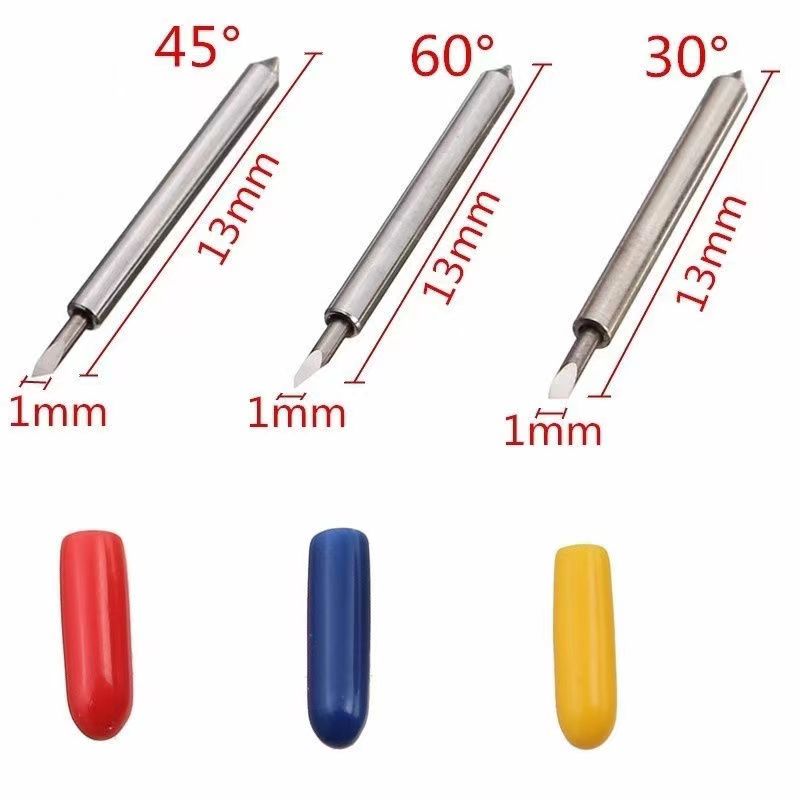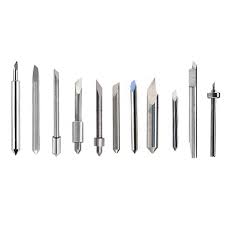Are blades interchangeable from one brand of cutter to another? How much of the blade tip should be exposed? What blade angle should you use for different types of vinyl? How often should it be replaced? Just for the record, we’re also talking about knives and needles; two other terms for plotter blades. Whether you call them blades, knives or needles, the answers to all your cutting questions are found below.
Does it Matter which Brand I buy?
Generally speaking, vinyl cutter blades are not universally compatible. The blade has to fit snugly in the blade holder and the blade holder has to fit snugly in the tool carriage. So whether you’re purchasing a new blade or blade holder, you have to make sure it’s compatible with the brand of cutter you’re using.
Graphtec vinyl cutters use Graphtec blades, Roland DG cutters use Roland blades, Gerber cutters use Gerber blades and so on. The exceptions come when you move beyond the top tier brands into newer manufacturers. Once upon a time, the top-selling vinyl cutter in the country was the Roland Camm-1. At that time, a lot of new companies like GCC were trying to break into the market. So they decided to make their plotters more appealing to consumers by designing them to be fully compatible with Roland blades and blade holders. This is why our OYEABlades fit a fairly wide variety of cutters including Vinyl Express Rogue Series, R Series, EnduraCUT series, BobCat, Lynx, and Panther cutters, and all Roland plotters. All Vinyl Express brand cutters except the Q series are compatible with Roland blades. The Qe and Q Series cutters use Graphtec blades and blade-holders.
How Much of the Blade Should be Exposed?
Plotter Blade settings guide - blade lengthWhether you’re buying and installing a replacement vinyl plotter blade or installing the OEM blade in a brand new cutter, the first thing you have to know is how much of the blade should be exposed. If you have enough blade sticking out to clearly see and feel the tip, it’s probably too far out. Most new vinyl cutter owners improperly install the blade with too much of it protruding from the holder. Set it so that you can barely see the tip. Then take the blade holder and manually drag it across a sheet of vinyl making a box pattern or square. You should be able to weed that easily, but you shouldn’t see deep scoring of the release liner. If you flip the vinyl over, you should not be able to feel the cut line in the back of the liner. If you can cut vinyl manually without carving up the liner, you’ve gotten it right (See left). Now install the blade holder in the tool carriage, adjust the cutter’s force setting, and perform a test cut. Tweak the cutting force until you get the same result. The only time you need more blade tip exposed is when you’re cutting very thick material like heat transfer flock or sandblast stencil film. Otherwise, use the ‘less is more’ rule.
Which Blade for What Vinyl?
Fig 2: A 45° blade works for most media. For thicker material, a 60° blade is more effective.
Fig 2: A 45° blade works for most media. For thicker or tougher materials, a 60° blade is more effective.
Here’s the $60,000 question. Which blade should you use for which vinyl? The three most commonly used plotter blade angles are 30, 45, and 60 degrees. Many manufacturers only use 45 and 60 degree blades. Time for a little geometry refresher. The angles are referred to in terms of degrees because the cutting depth is determined by the angle of the intersection of the cutting edge and the shaft. (Fig 2). For standard sized graphics in most calendered PVC vinyls, a standard 45° blade works fine, if correctly installed (see above).
If you have a 30° blade option, use that for standard sized graphics in thin films like cast vinyl and ORACAL’s delicate 1mil 352 chrome. For standard sized graphics in thicker or tougher films like retro-reflective film, sand blast stencil, or flock, a 60° blade is recommended because it cuts more deeply into the film. All of these fit in the same blade holder. The only difference is the angle of the tip.
What about super-dense, diamond-grade reflective? Some high intensity prismatic reflective films, such as Nikkalite Crystal Grade reflective, cannot be cut with any plotter using any blade. For 3M 3930 diamond grade reflective, special blades are recommended.
PREV : Everything You Need To Know About Tungsten Carbide Insert Knives NEXT : Main models of Teseo cutter blades Catalog Consumables Spare parts







